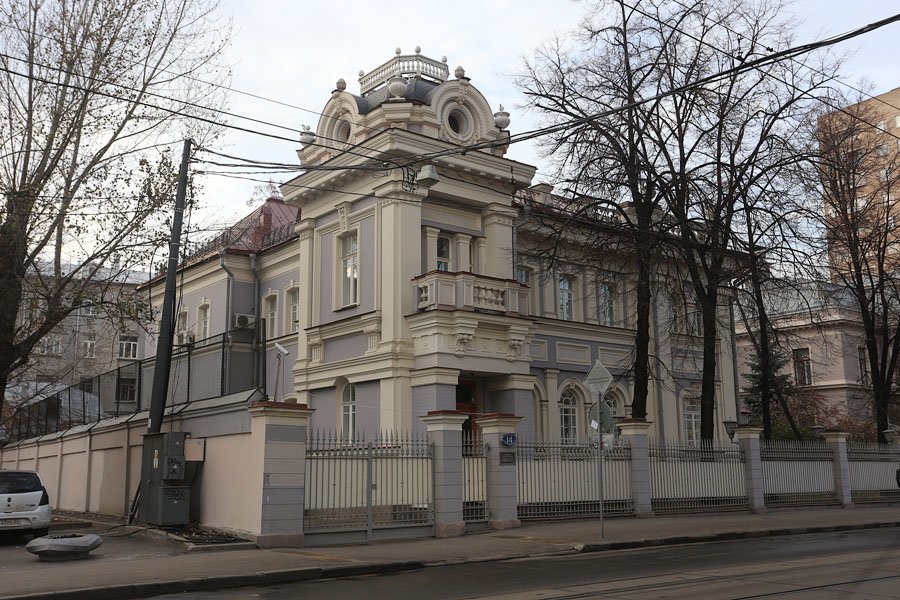К югу от дома Урусовых, на соседнем участке 14, за той же оградой работы архитектора И. И. Рерберга стоит особняк, построенный в 1900 году по проекту В. В. Шервуда для торговца обоями Сергея Гавриловича Протопопова. В 1911 году сын С. Г. Протопопова Николай продал участок графу Владимиру Сергеевичу Татищеву (1865 – 1928). Граф немедленно приступил к перестройке дома, для чего пригласил архитектора Густава Августовича Гельриха. Он изменил и отделку фасада, и планировку здания, внеся черты неоклассики в эклектичную отделку здания.
От работы архитектора В. В. Шервуда неизменной до середины ХХ века оставалась только ограда с решеткой сложного рисунка. Ограду заменили на новую при передаче здания посольству Индонезии в середине 1950-х годов. Теперь владение графа Татищева и его соседей Урусовых объединены одинаковой оградой, выполненной по проекту И. И. Рерберга.
Вскоре, в 1913 году, тот же Г. А. Гельрих строит для В. С. Татищева комплекс неоклассических доходных домов на участке, примыкающем к особняку с запада и выходящем на соседнюю Пятницкую улицу, 43. Таким образом, собственный дом графа и его доходные дома в случае соединения участков составили бы большое владение от улицы до улицы.
Граф Владимир Сергеевич Татищев был не только знатен, но и богат, он являлся одним из наиболее успешных банкиров и промышленников России. С 1909 года В. С. Татищев был председателем правления и директором Соединённого банка, образовавшегося от слияния трёх банков, входивших в банковскую группу Л. С. Полякова. Это Московский Международный торговый банк, Южно-Русский промышленный и Орловский коммерческий банки. Отделения Соединённого банка работали в 68 городах России. Соединённый банк создавался Министерством финансов России с целью нормализации финансового положения в бывших банках Полякова и вместе с тем сохранения их клиентуры. Здание банка стоит до сих пор на углу Кузнецкого моста и Рождественки.
После 1917 года дом Татищева был плотно заселен несколькими десятками жильцов.
В 1950-е годы соседние дома Урусовых и Татищева были переданы под посольство Индонезии. При приспособлении зданий был сделан капитальный ремонт, многие помещения получили новое оформление. Был изменен вход в особняк Татищева, а вместо открытой террасы с севера от здания был построен двухэтажный легкий застекленный объем.
Two two-storey mansions of the early twentieth century on Novokuznetskaya street united by one fence now and have a common address. This is the territory of the Embassy of Indonesia. However, until 1917 they were two separate properties.
To the south Urusov’s house at a nearby section 14, behind the same fence designed by architect IM Rerberg there is a mansion built in 1900, designed by Vladimir Sherwood for merchant wallpaper Sergei Gavrilovic Protopopov. In 1911, the son of SG Protopopova Nicholay sold the property to Count Vladimir Sergeyevich Tatischev (1865 - 1928). Count immediately proceeded to the restructuring of the house. He invited architect Gustav Avgustovich Gelrih. He changed the finishing of the façade and the layout of the building, inserting neo-classical buildings features in an eclectic finish.
From the work of the architect V. Sherwood unchanged until the mid-twentieth century, only fence with lattice complicated pattern left. The fence replaced during the transfer of the building to the Embassy of Indonesia in the mid-1950s. Now the possession of Count Tatishchev and its neighbors Urusovs combined behind the same fence, designed by the project II Rerberg.
GA Gelrih builds tenement houses complex in the neoclassical on the area adjacent to the house from the west and overlooking the adjacent 43 Pyatnitskaya street for VS Tatishchev soon after, in 1913. Thus, the Count’s own house and his apartment buildings in case of connection of properties would have been one great plot located from street to street.
Count Vladimir Sergeyevich Tatischev was not only noble, but also rich; he was one of the most successful bankers and industrialists of Russia. Since 1909, VS Tatischev was the Chairman of the board and director of United Bank, formed from the merger of three banks that were part of Polyakov’s banking group. This were Moscow International Commercial Bank, South Russian industrial and Orlovsky commercial banks. Branches of United Bank operated in 68 cities across Russia. United Bank created by the Ministry of Finance of Russia in order to normalize the financial situation in the former Polyakov banks and to maintain their clientele at the same time. Bank building still located on the corner of Kuznetsky Most and Rozhdestvenka.
After 1917, several dozens of residents densely populated Tatishchev’s house.
In the 1950s, the neighboring houses of Urusovs and Tatishchevs were transferred to the Indonesian Embassy. When the adaptation of buildings was renovated many rooms got a new look. The entrance to Tatishchev’s mansion was changed, and instead of an open terrace, two-storey glazed light volume built to the north of the building.










%20BEL_0521.jpg&w=1920&q=75)







.jpg&w=1920&q=75)